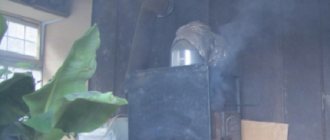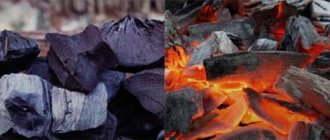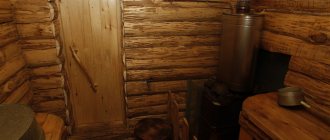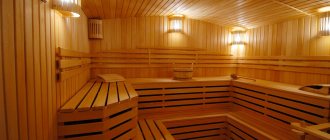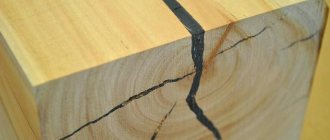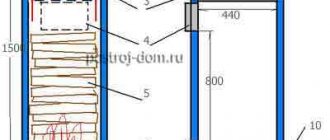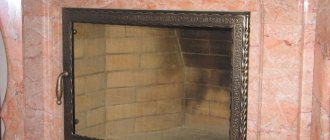Selecting a solid fuel unit
After analyzing the cost of heating in various ways, I settled on a solid fuel coal heating boiler. Indeed, the cost of diesel fuel and electricity is constantly rising. Currently, heating with coal is approximately four times cheaper than heating with diesel or electricity. Gas is also not an alternative, since it is very expensive to carry out due to the notorious corruption component. The price of gas inevitably tends to the world price, as Gazprom understands it. The gas pressure in pipes in many areas at the peak moments (at extremely low temperatures) drops so much that boilers turn off and houses freeze out.
The main disadvantage of a coal boiler is the need to regularly (2-3 times a day) load it with fuel. If you agree to this, then a solid fuel boiler is your choice. Before installation, you need to decide on the power of the boiler, its installation location, the pipe layout from it and the coolant circulation system.
| Here is a selection of materials: IN Everything you need to know about heating and climate control Features of the selection and maintenance of boilers and burners. Comparison of fuels (gas, diesel, oil, coal, wood, electricity). Do-it-yourself ovens. Coolant, radiators, pipes, heated floors, circulation pumps. Chimney cleaning. Conditioning |
Long-burning solid fuel pyrolysis gas generator boilers
The operation of such boilers is based on fuel gasification. The firebox of such a boiler is divided into 2 halves horizontally. The upper half, which is also a loading chamber for fuel, firewood does not burn, but smolders. When exposed to high temperatures, firewood releases various flammable substances, which become the main fuel for the boiler, burning in the second chamber located below.
The described operating principle of boilers significantly increases the efficiency of such samples, in this case we can talk about 85 or even 90%. The fuel burning time also increases significantly, reaching up to 12 hours. The fact is that in the boilers under consideration, the process of direct combustion of fuel occurs only in the lower chamber.
In the upper loading chamber, the firewood only smolders, releasing flammable substances. After this, flammable substances are mixed with air and sent through a special nozzle to the second, lower chamber, where they become the main fuel for such a boiler. In the process of burning a mixture of air and gases released from firewood, it is possible to reach quite high temperatures, so the lower chamber, in which the combustion process takes place, is lined with a special heat-resistant finish.
The fuel in the boilers under consideration burns out almost completely, which also allows us to talk about the efficiency of the boiler. In addition, due to its technical features, the boiler does not form soot and ash during operation. In order for the pyrolysis boiler to fully perform its functions, it is necessary to fully pump air into the device.
The boilers in question are complex and expensive equipment. In most cases, the design of such boilers includes:
- Smoke exhausters;
- Electronic devices for managing the boiler’s operating process and effectively monitoring it.
An important condition for proper operation of a pyrolysis boiler is the level of fuel moisture. The humidity of the firewood that will be placed in such a boiler should not exceed 25%. Practice shows that firewood stored in a woodpile can boast such a percentage of humidity only 24 months after the start of storage. The boiler is also demanding on the size of the fuel: the thickness of the firewood that is prepared for loading into such a boiler should not be less than 100 millimeters. The minimum boiler power that can be considered controllable is 50%; in cases where the boiler power drops below the indicated value, the operation of the device becomes unstable. This suggests that the boiler is well adapted for operation in cold periods of the year, but is completely unsuitable for effective operation in the off-season.
Pyrolysis boilers from manufacturers such as VERNER and ATMOS can boast excellent reviews from users who have managed to study and test this technique in practical application.
Connection to the chimney
An important part of the design of a long-burning stove is the chimney and pipes for connecting to it. The chimney diameter must be at least 100 mm, preferably even more. This heating device requires three metal elbows and a plug. To pass through the wall, this particular design also uses a pass-through glass. All connections must be sealed.
Connection sequence:
- the first part of the metal pipe is welded to the upper surface of the stove ;
- then the remaining elbows (up to the wall);
- a hole is cut in the wall in accordance with the diameter of the glass;
- a metal pipe is passed through it .
If the chimney is brick , this is where the work ends. If there is no brick structure, you need to install a metal pipe (minimum length 4 m), to which the elements extending from the heating device should be connected. In addition, a metal chimney needs insulation, which will reduce the formation of condensation. It is advisable to attach a special fungus to the top of the pipe to prevent debris and moisture from getting into it.
One of the most economical stoves is the Breneran Aqua device with a water circuit. The operating principle and nuances are outlined here:
The combustion process of solid fuel is divided into three stages
- ignition (ignition),
- active combustion
- afterburning.
- In the first stage, solid fuel is first heated and dried and at a temperature of 105 - 110 ° C loses its moisture.
- Then, at a temperature of 300 – 400 °C, it begins to decompose into volatile substances and a solid residue.
- With further heating, when its temperature becomes equal to the ignition temperature, the fuel ignites. The ignition temperature (approximate) of various fuels is as follows, °C: firewood - 300; brown coal – 300 – 400; coal – 450 – 500; anthracite – 700 – 750; liquid fuel 500 – 600; about 600 gas.
- The active combustion stage is characterized by high temperature (more than 1000 °C) with maximum heat release and the highest consumption of air (oxygen) spent on the combustion of coke and volatile substances.
- Afterburning of solid fuel is characterized by decreasing heat release and decreasing demand for air.
Signs that you're crazy
Carbon monoxide is very toxic. Symptoms of CO poisoning are:
- Dizziness,
- Hearing loss
- Deterioration of coordination,
- Deterioration of vision,
- Headache,
- confusion,
- Labored breathing.
In the future, nausea and loss of consciousness may occur. At the first signs of poisoning, you should quickly leave the room. It is recommended to cover the lower part of the face with a wet cloth when moving. Under no circumstances should you sit on the floor - carbon monoxide is heavier than air, and its concentration is higher near the floor. Victims of severe poisoning must receive first aid and call a doctor.
Solid fuel boilers in which combustion occurs naturally
Boilers of this type differ from their analogues in that all the wood that was placed in the firebox burns simultaneously, that is, the process of burning solid fuel, in this case firewood, occurs naturally.
The advantages of boilers of this type traditionally include simple design and low cost of the product. Such a boiler is lenient with the quality of firewood and does not cause difficulties during maintenance, which can also be attributed to the asset of the device.
The operator of such a boiler can control the power of the device, but this figure can fluctuate between 60 and 100% efficiency, the specific figure depends on how intense the combustion is. The combustion intensity is regulated using a special damper, which limits the entry of air into the boiler. Along with power, the efficiency of the device inevitably decreases.
Practice shows that the maximum efficiency that such boilers can boast is 80%. When talking about the disadvantages of solid fuel boilers with a natural type of fuel combustion, it is customary to remember that the process of fuel combustion occurs in the shortest possible time. As a rule, one batch of firewood placed in the boiler is enough for no more than 4 hours.
Methods for supplying secondary air to the furnace
- Secondary air supply through the firebox door.
- Supply of secondary air through a special hole in the furnace body.
- Supply of secondary air through the silo.
- Secondary air supply through a special brick channel inside the furnace.
1.Supply of secondary air through the firebox door.
The most common method of supplying secondary air to the furnace.
Many modern stove doors have special openings on their body to allow air to pass into the firebox. Usually these holes are conveniently closed with a gate. This damper regulates the amount of air supplied.
Supply of secondary air through a special hole in the furnace body.
The advantage of this method is that it can be delivered exactly to the place where unburned substances accumulate.
The difficulty is that it is not easy to determine such a magical place in the oven.
And the biggest difficulty is that the hole in the stove does not comply with fire safety standards.
Supply of secondary air through the silo.
A silo is a channel for the passage of air from the furnace ash to the secondary air supply area. The silo is made of stainless steel and installed in the oven with expansion gaps for possible expansion.
Arranging the supply of secondary air through a silo is a fairly technical and modern solution in the construction of furnaces.
To properly install silos in a furnace, it is important to understand the combustion processes in the furnace and the consequences of fire on the materials. In fact, few stove makers use this method, because
this is a rather complex undertaking requiring clarity of design and good quality silo material
In fact, few stove makers use this method, because... This is a rather complex undertaking that requires clarity of design and good quality silo material.
Secondary air supply through a special brick channel inside the furnace.
A good way to supply secondary air, provided there is enough space inside the oven.
I usually have trouble placing another secondary air duct inside the furnace.
Usually you design a furnace with maximum power in a minimum size and there is simply no room left for an air channel, but if you are not limited by size, then making a secondary air channel out of brick would be a good solution.
Perhaps there are some other more exotic methods for supplying secondary air to the furnace.
Heating fireplace stove
It is simpler and easier to install a door with holes and a gate; this method works and does not require any tricks.
Why is it prohibited to heat an undried stove?
A stove that has not been thoroughly dried cannot be used, as otherwise the brickwork will become covered with cracks. The largest number of cracks of various sizes will appear in the firebox area. This is due to the presence of the highest temperature in this place. For wet bricks, high temperature is a dangerous factor. During the subsequent cooling of the furnace, the cracks formed may decrease somewhat in size, however, they will remain for the entire period of subsequent operation of the structure. An attempt to cover up the cracks that have arisen with a solution will not correct the situation. That is why the oven must be thoroughly dried before use.
